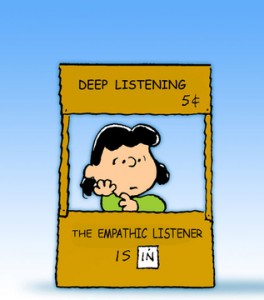 Recently, I was asked if it was possible to build the capacity for empathy and strengthen one’s emotional intelligence (EIQ). The short answer is–Yes!
Recently, I was asked if it was possible to build the capacity for empathy and strengthen one’s emotional intelligence (EIQ). The short answer is–Yes!
The longer answer is a bit more nuanced. Many leaders today are conditioned by the educational industrial complex and other societal forces to favor left-brain, rational, analytical thinking. While that approach is useful, such conditioning tends to atrophy the right-brain capacity for empathy and EIQ. And, what we know now is that successful organizations in the modern economy require leaders to access their rational/analytical, AND emotional capabilities.
So, how do we reconnect with and increase our innate capacity to understand and share the feelings of another? The first step is to go back to basics and retrain ourselves to listen.
I’m not talking about the kind of listening you’ve become accustomed. Like the voice in you’re head right now may be saying any of the following:
- “What’s he talking about? I know how to listen.”
- “You’ve got to be kidding me.”
- “Is he right or is he wrong?”
- “Can I trust this?”
- “Do I agree or disagree with what he’s saying here?”
- “Get to it. What’s the answer?”
- “Is this true, or is it false?”
- “What’s the problem here? Where’s the solution?”
In the leadership context, we refer to that kind of yackety-yak as “Level 1 listening”. When you’re listening at Level 1 you may hear the words of the other person, but you are primarily aware of your own opinions, stories, judgments — your own feelings and needs. There’s nothing wrong with listening at Level 1, it’s just that it’s so habitual we’re often not even aware that we’re almost always listening at that level. Also, Level 1 is NOT empathic listening.
So what is a leader to do? Kick it up a notch and go to Level 2.
With Level 2 listening all of your attention is directed towards the person who is talking. Mature nonprofit professionals that engage in 1:1 fundraising work learn to cultivate listening at Level 2. Level 2 listening is when 80% to 90% of your attention is on what the other person is saying. It typically consists of focusing on the words coming out of the other person’s mouth. During the 10% or 20% of the time you are speaking, you might say something like this: “What I hear you saying is…,” or “What I notice is….” We call this “articulating” or reflecting back what the other person is saying for clarification, understanding, and meaning. Nonprofit leaders who strengthen the ability to listen at Level 2 often (although not always) become extraordinary fundraisers.
Another way to consider Level 2 listening is to remember when you were on an interview for a job you really wanted. You may have asked your future boss questions about the role and culture. Because you really wanted this job, you listened to the answers with heightened measure of intensity. You absorbed each and every word to fully understand what you were receiving.
Leaders who listen at levels 1 and 2 generally have higher EIQ and are often seen by people with whom they engage as attentive, caring, and concerned. In order for leaders to be as effective as possible, they need to be able to listen at Level 2, and then they need to add the ability to listen at Level 3.
Level 3 listening involves panoramic awareness. It requires that you take in the entire environment. What is the other person’s body language? How does his/her facial expression change as s/he speaks? How does this person react to your open ended questions? What emotion is coming through as the conversation unfolds (sadness, enthusiasm, frustration, joy, etc.)? Level 3 listening requires that you self-manage your Level 1, and that you remain present, open, flexible, and non-judgmental as you engage in conversation. It also requires that you tap into your intuition.
Intuition is the ability to understand something (or somebody) immediately, without the need for conscious reasoning or data. Thomas Edison honed this ability. He claimed that his invention of the phonograph was an act of pure intuition. Great fundraisers regularly tap into their intuition and express their “intuitive hits” with donors. The expression may take this form: “My sense is that you’re interested in….,” or “I have a feeling that you’d really love…”
While we all have the intuitive capacity, we often fail to use it. For me, intuition sometimes manifests as a visual image in my mind, a metaphor, a feeling, or just a word that pops into my head. In my executive coaching work, I notice that successful leaders often listen to these intuitive “feelings,” while struggling leaders do not. Steve Jobs famously followed his own iconoclastic decision-making impulses. He implored his colleagues at Apple to “have the courage to follow [their] intuition.”
David Langiulli is a certified professional coach who helps nonprofit leaders flourish and thrive. He is also the author of The Essential Leadership Guide for Nonprofit Professionals.